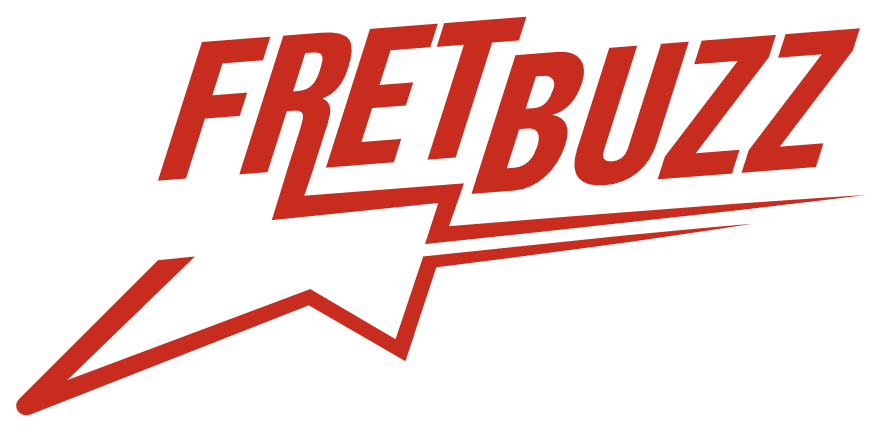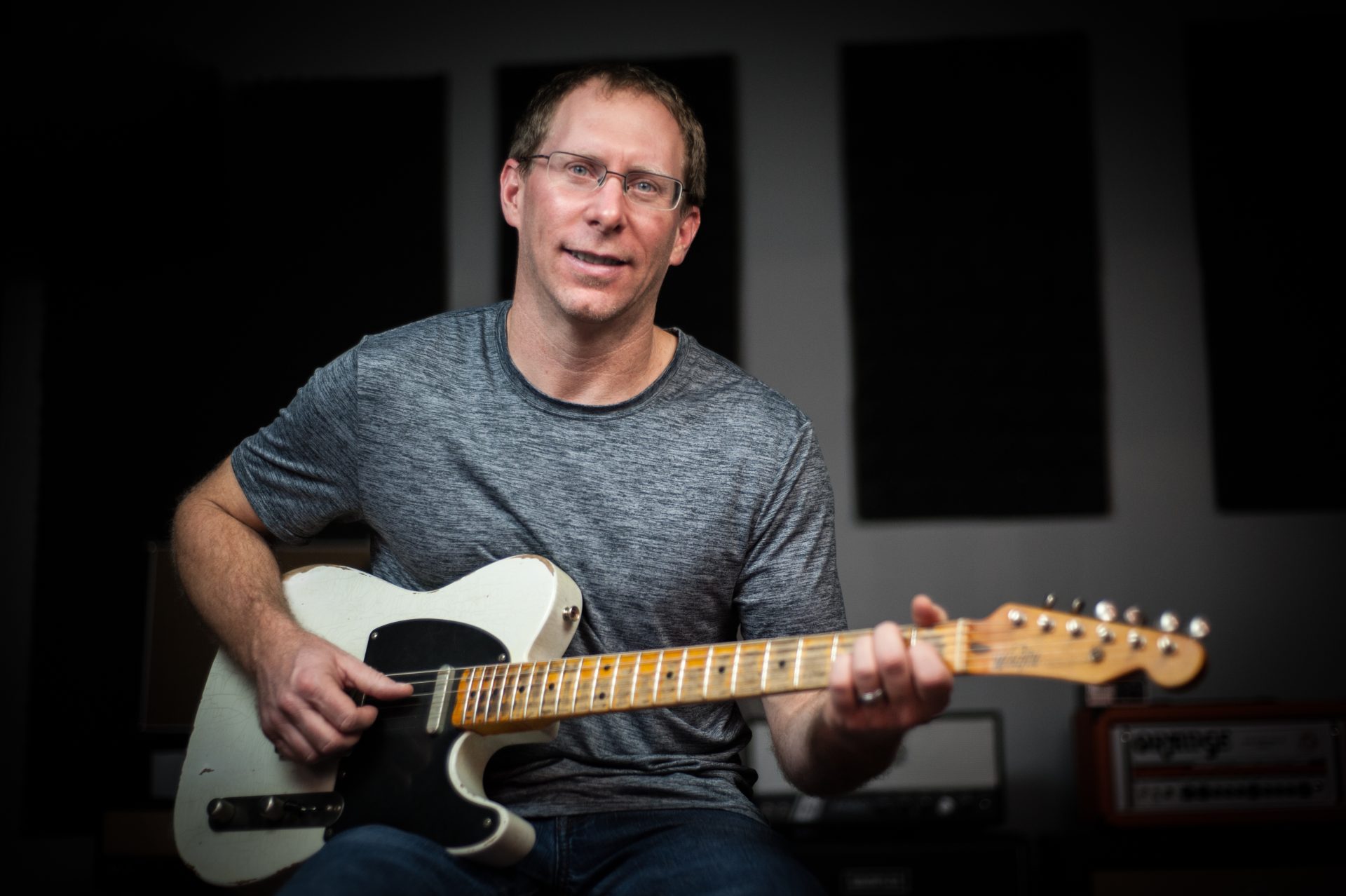by Jon Wiederhorn
“Don’t turn the gain all the way up. Just because it goes to 10 doesn’t mean it should be there.”
Whether you’ve never hooked a stomp box up to your guitar, or you’ve got a pedal board that would put Radiohead to shame, there’s probably something you don’t know about the fine art of effect twiddling. That’s why we scheduled an appointment with the doctor of tone, Wampler Pedals founder and CEO, Brain Wampler, to discuss the many options that exist for today’s guitar players that want to transmogrify their sounds beyond the possible restrictions of their amp. During an in-depth conversation, Wampler answered questions about what pedals work best for different music styles, how these little push-button boxes are typically positioned in a signal chain, what to do with all those knobs and switches, whether it’s wise to combine pedal tone with amp gain, and so much more.
Wampler Pedals are one of many boutique companies making high-quality effects to suit the specific needs of their users. For connoisseurs, and those without budget concerns, their reliability, ease of use, sound, and sturdiness are well worth the price. That being the case, Wampler is the first to admit that cash-strapped players and folks who want to dip a toe into the exciting world of guitar effects before they commit to spending big bucks on what can quickly become an all-consuming addiction, might benefit at first from the pedals you can pick up at Guitar Center or online for $100 or less. Some of these do a fine job, especially the tried-and-true offerings by companies like Boss, Ibanez, Fender, and Line6.
For the beginner pedal consumer, choosing pedals can be tricky. It was even tough back in the day when there were only a few companies making good dirt effects. In the mid ‘80s, maybe you have fond memories of connecting a Boss DS-1 to your signal chain and riffing along to classic rock and hard rock songs. Add a chorus, flanger or phaser and you could even approximate the tones of Eddie Van Halen. Perhaps you were a blues devotee who cherished your Ibanez Tube Screamer to capture that Chicago blues sound, or even the Texas twang of guys like Stevie Ray Vaughan. And, if you were a dedicated headbanger, there’s a good chance you blasted through walls with a “Digitech Metal Master Heavy Metal Distortion” (the actual name) or the Boss HM-2 Heavy Metal or MT-2 Metal Zone pedals.
Modulation pedals like tremolo, rotary, univibe, phasers, wahs, flangers, choruses, reverbs, delays, and ring modulators have been around for a while, of course – some for decades (see history chart below) – but many lacked the sophisticated algorithms found in some of today’s digital gear which allow parameter shifts that can make guitar tones sound like they’re coming from another galaxy. Then there are the multi-effect units, which are capable of emulating a wide variety of amps, pre-amps, and cabinet tones, as well as effects, and practical components like compressors, equalizers, and noise gates (though results can vary widely from one unit to the next). Finally, there are computer plug-ins, for use with computer DAWs, which can do just about anything. If you know how to use them properly (and they don’t crash your system), they make adding effects to music as easy as sprinkling salt and pepper on a well-cooked piece of meat.
If you’re new to all of this and your head is starting to spin we sympathize… and want to help! So, instead of reading my sophomoric ramblings, let’s turn the proceedings over to Wampler, who’ll guide us through the ins and outs of pedal pushing and sound manipulation without digging too deep in the weeds. First an introduction:
Wampler’s pedal perfecting dreams began in his youth when, while watching his older brothers’ band rehearsals, he decided the tones created by their stock guitar pedals didn’t sound so great. His efforts to improve pedal sounds began with modding existing pedals. But as he tweaked the electronics, he started to realize that he needed to design entirely new circuits to achieve the sounds he wanted to hear from his guitar pedals.
These tone-chasing adventures led to him to design new overdrive and distortion pedals for various clients. Early in his career, he tossed a pedal onstage at a Brad Paisley concert, assuring the country star that the pedal would sound great with his rig. To Wampler’s delight, Paisley became a customer and commissioned Wampler to create the country artist some custom pedals. As Wampler expanded his business, he assembled a team of professionals who worked with him to craft pedals that met his exact specifications. In addition to his work with Wampler Pedals, Wampler is the creator of GuitarPedalCourse.com, an educational platform dedicated to teaching aspiring pedal builders the art and science of guitar pedal design.
As an instructor, he describes complex ideas in a simple way, and is dedicated to helping players find the path to the tone they’re after – which is why we tracked him down to talk to us in (mostly) layman’s terms about what these dang pedals do and how to use them.
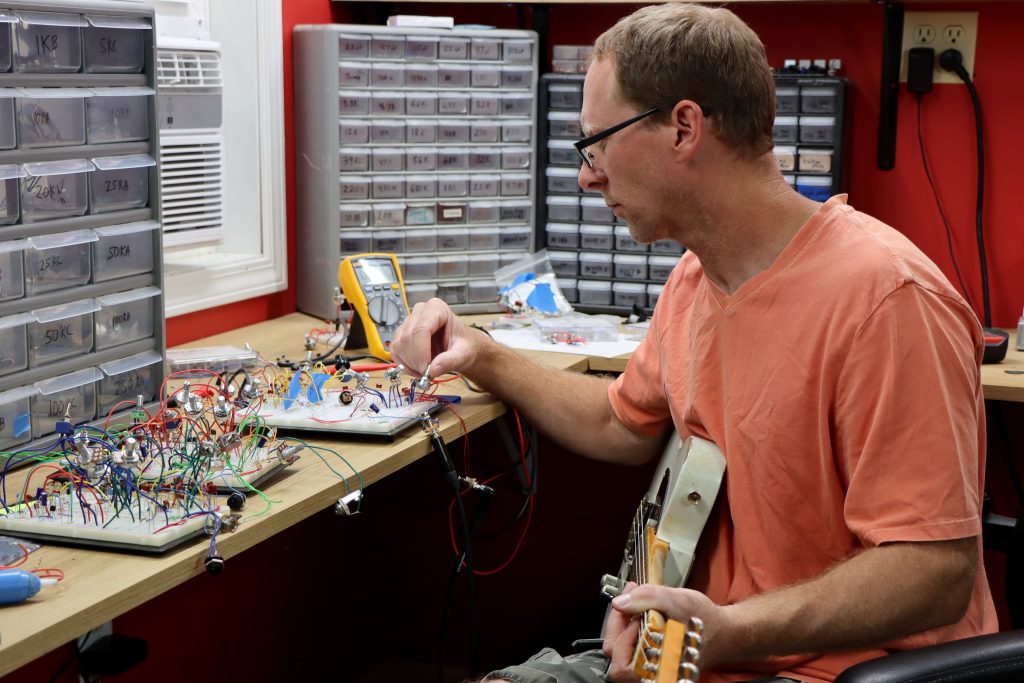
PLAYING IN THE DIRT
FretBuzz: For those who are just now taking a toe dip into the wonderful world of guitar pedals and don’t want to break the bank, what is the most practical first pedal to own?
Brian Wampler: I think the most common thing is an overdrive or distortion. That’s the most common thing people get into, but there are a million different types of pedals and they all work differently, so it gets really confusing. A common question I get is, “Which one should I buy first?” That’s tough to answer because for Wampler – just for us – we might have 14 different overdrives. There are a lot of dirt pedals to choose from. So there are a lot of questions to ask: “Okay, what type of music are you playing? What type of guitar are you playing? Will you be playing through an amp, and do you use the dirty channel on your amp? Do you want this pedal to go with the dirty channel?” And so on.
FretBuzz: A lot of players play distortion pedals through a clean channel on their amp and use the pedals to shape their sound. Is that the best way to use pedals, and isn’t there a danger of one signal overpowering the other when you use amp gain along with a dirt pedal?
Wampler: There can be, but they can also work together really well. Anything can “work” depending on what sound you want. If you want to put a little something extra on your amp distortion, you want a Klon kind of thing. Or you want a Tube Screamer. A lot of the time, the best way to use those pedals is to really hit an amp and make it even dirtier. It’s almost a boost – though a really dirty boost.
FretBuzz: Do amp modelers work well with various amp settings?
Wampler: As amps become less and less common, that can be the case. Say, you’re using a Fender amp modeler and you want to have a pedal for that. There are so many different options. It’s like, “Okay, what vegetable are you craving to go along with your main course?” And a beginning player isn’t going to know how to answer something like that. So, it gets really difficult.
FretBuzz: Do you suggest players try various options and pick a sound they like?
Wampler: I’ll often ask, “Okay, what are your three top favorite guitar tones?” And maybe they’ll say, “I like Joe Bonamassa, Eddie Van Halen, and Jimi Hendrix.” So then I’m like, “Okay, so for an Eddie Van Halen thing, from our line you’ll want a Pinnacle Gearbox thing.” If you think of Joe Bonamossa, I’m going to say, “You probably want to dirty your amp and I’ll pick an overdrive for you.” But I’m just picking from our pedals. If I was going to give that advice to someone for all brands, it gets really difficult. There are probably 500 pedals I could recommend.
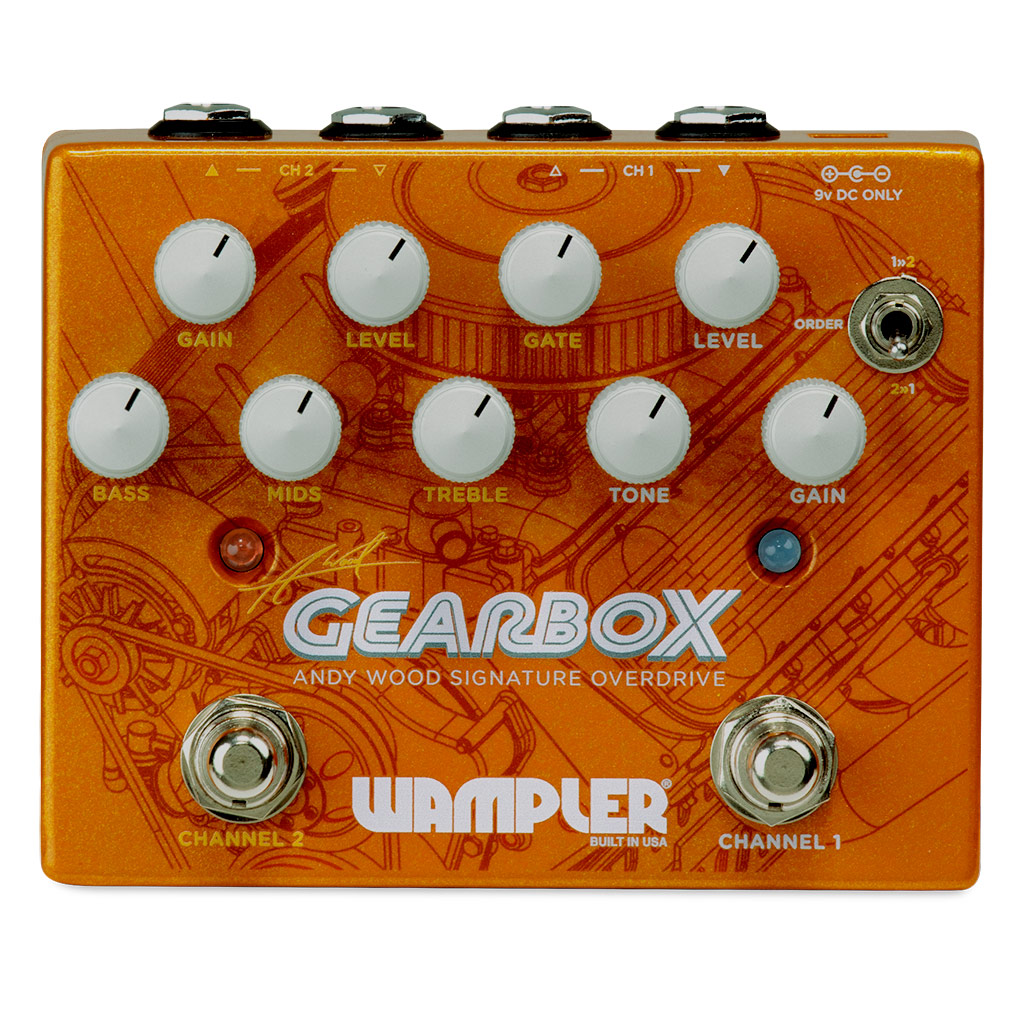
FretBuzz: Since you mentioned other brands, one of the most popular first pedals for players to start with is the Boss DS-1 orange distortion. Is that a good place to start?
Wampler: I don’t take it in a bad way when people ask me about pedals from other brands because I look at these things like spices. Sometimes you need pepper, sometimes you want salt, and sometimes ketchup is the right flavor. It really depends on what the person is looking for. If someone wants a basic distortion, the DS-1 is a pretty decent pedal. I wouldn’t say it’s a great pedal, but it’s decent, especially if they’re into a basic rock or hard rock sound. But if I was going to recommend something from the Boss line for a player to start with, if they’re using a Stratocaster or a Telecaster, I would probably say they should start with a Blues Driver, say the Boss OD-3. I would probably lean more in that direction. Now, it’s not going to have as much gain as you would want if you’re going for a distorted ‘90s rock sound. It gets difficult to explain without a person going to a store, sorting through a bunch of pedals and saying, “I like these four the best.” But one of the drawbacks of the internet is that it’s hard to do that now. You can’t go to a store and try a lot of pedals because a lot of these stores don’t even carry that many pedals.
FretBuzz: That’s a good point, and because of that a lot of players are going in blind. Even if they’ve searched the internet to find out the sound of different pedals, the limitations of the audio — whether from the person who recorded it or the user’s speakers – offer limited revelation on the sound of the pedal or how it will behave with different amps. At least a lot of internet sales sites have good return policies. But for someone starting with zero knowledge of pedals and just wants to rock, it seems important to know the difference between overdrives, distortions, and fuzz pedals, and understanding how each of those pedals will work with amp gain. You mentioned how you can get a great boost by having an amp set on high gain and using a Tube Screamer.
Wampler: On the flip side of that, there’s a Stevie Ray Vaughan sound, for example. There’s a lot of songs where he’s using a loud, clean amp, and all the dirt is coming from the Tube Screamer. And sometimes, he stacked his Tube Screamer depending on the song. One thing that comes to mind is “If the House is Rockin,’” and when I hear that, I go, “That’s a classic Tube Screamer into a loud, clean amp – probably a bunch of loud, clean amps, and it’s all miked in the studio. But that tone is not the tone that Eddie Van Halen or Metallica would use. It’s its own thing that’s unique to an overdrive pedal.
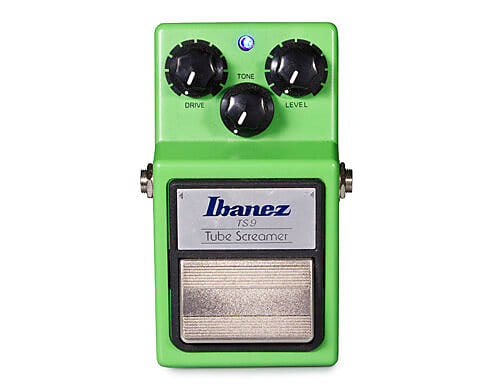
PEDAL TO THE METAL
FretBuzz: On that note, the first pedal I bought in my teens was a Boss DS-1 because I wanted to sound like Judas Priest or Iron Maiden. But when I plugged it in I was sorely disappointed that it didn’t have nearly enough gain for me. At the time, I didn’t realize I could have played it with my amp gain, but instead I returned it and bought a “Marshall-In-A-Box” distortion pedal, turned it to ten and scooped (removed) the midrange (mids). It was as close as I could get to that overdriven Marshall tone. Those pedals delivered maximum crunch, but sometimes at the expense of sound quality. From a sonic level, how do you feel about scooping the mids because midrange can play a big role for a full band sound and it’s a parameter that seems to be misunderstood. Or, is that what you want if your goal is to sound like Pantera’s Dimebag Darrell?
Wampler: Again, that answer requires some questions. Are we talking about a person that’s going to use a guitar amp?
FretBuzz: Yeah.
Wampler: Okay. So do they care if it’s solid state or tube? Are they looking at more of a budget option or are they looking at a higher priced thing?
FretBuzz: Let’s say you’ve got a player with a decent $500 guitar and maybe they’re playing a solid-state Marshall, a Positive Grid Spark, or a Boss Katana (see review here).
Wampler: Okay, well I’ll answer for the Boss Katana. I have one, and it’s one of those amps I wish I had as a kid because it does almost everything. It’s got every setting with a workable tone. I could play that at a gig all day long. Now, if you want that Pantera sound, aside from any amp models that would be on this particular amp, the thing that comes to mind – and it’s not easily achievable – is the Boss MT-2 Metal Zone, believe it or not. If you could find a modified one, where they took some of those honky mids out – those are fantastic for that sound. Dimebag Darrell heavily scooped a lot of stuff, and I think he was using Solid State Randall amps for a long time. With that Pantera tone, you’ve really got to have that tight bottom end — not a lack of lows — but just not loose and fluffy, for lack of a better description.
FretBuzz: Despite its popularity, the original Metal Zone has been negatively criticized by many pedal purists.
Wampler: Yeah the Metal Zone gets a lot of crap, though a lot of that is because, circuit-wise, it’s almost like there’s a stuck wah in part of the circuit. So it creates this honky tone that everyone else tries to dial out. But one of the first things a person does when they modify it is to pull out a few capacitors, and that gets rid of that filter completely. And, now it’s a great distortion that sounds like a [Fulltone] OCD but with more EQ flexibility. Also, with the newer versions of the OCD, as you turn the gain up, you start getting a lot of bass. It’s a cool texture, but it stops being so tight. And with a lot of metal tones, you’ve really got to have that tight bottom end.
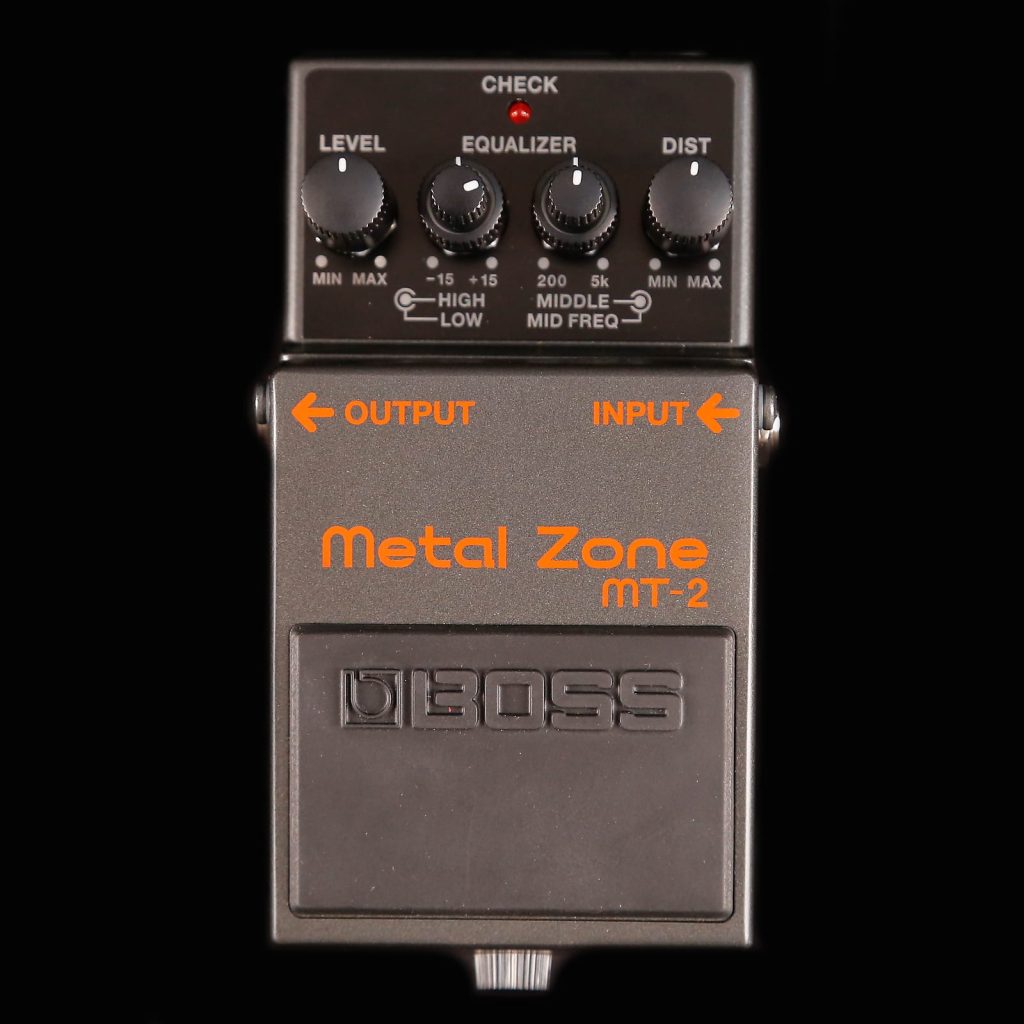
OVERDRIVE, DISTORTIONS, OR FUZZ?
FretBuzz: It can be so disappointing to buy an overdrive pedal when you’re really looking for the sound of a fuzz. What are the sonic and technical differences between overdrives, distortions, and fuzzes?
Wampler: Okay, so technically, you’ll hear a lot of people on the internet talk about clipping: There’s soft clipping, which we generally refer to as overdrives; hard clipping, which we generally refer to as distortions; and then there’s even harder clipping, which is more of a square wave thing, which is typically what we would call a fuzz. In basic terms, the harder the clipping, the more intense the distortion. So, a fuzz is going to distort that note way more than an overdrive would. With that said, they all do the same thing. They take a nice pretty sine wave and then clip off the tops and the bottoms so it sounds distorted.
FretBuzz: It’s strange that people comb through all these different pedals and spend all kinds of money to, essentially, destroy or damage a perfectly good soundwave.
Wampler: The engineering world is weird. When a person goes to school and deals with audio, most of the talk is not about how to clip a signal or how to distort a signal. In fact, it’s usually the opposite. “This is how to prevent a good signal from becoming distorted because distortion is the devil.” And then these people get a job with a guitar company or a pedal company, and they’re like, “No, no. We’re trying to distort everything, just in a pleasing way.” That’s the secret.
PICKING YOUR PICKUPS
FretBuzz: Even some good guitarists don’t understand much about pickups. Maybe they use humbuckers for a thicker sound and single coil pickups for a creamier tone, or they switch between the bridge and neck pickup depending on whether they’re playing rhythm or lead, but sometimes the decision seems almost arbitrary. Do you have any quick tips?
Wamper: I’d say mess around with both and see what you like. A lot of my suggestions depend on what guitars you’re using. With the Telecaster, I can get a lot done — probably a lot more than with a Strat. The Strats are a little bit thinner. Telecasters can be a little more beefy. And if I’m using a Les Paul mostly I’m looking for a thicker or heavier sound. For the most gain, you’ll want humbuckers, but you’re gonna lose some clarity. With single coils you’re gonna gain some clarity, but you’re gonna lose some of the meat of a distorted tone.
FretBuzz: What’s your advice about using multiple pedals in a chain?
Wampler: There are traditional ways people place pedals, and then for experimental bands like Sonic Youth or My Bloody Valentine, it’s all about turning everything on its head. Traditionally, you’re gonna run overdrive into distortion into modulation into delay into reverb. But that’s not a rule. It’s just historically what most people have done, but you can absolutely run a delay into a distortion if you want a different sound. Van Halen did that a lot. He would run a tape delay into a cranked amp, and it sounded great. He’s not the only one that’s done something like that. A lot of artistic creativity can be explored by bending the rules. You just have to say, “Okay, well traditionally we run this pedal into that one. What happens if I do it backwards?” Maybe you’ll get a cool tone and maybe it will inspire you to want to play more. To me, that’s the name of the game – to find these toys and find cool ways to play with them.
HALTING THE HUM
FretBuzz: Is it helpful to have a noise gate or an EQ pedal in your signal chain?
Wampler: I tend to think an EQ is probably the most handy thing to have because you can use it to make a bad sounding pedal or amp much better. Not only that, you can use it to shape a pedal into doing something different. For example, you can take an EQ and run it into a distortion, but when you boost up the bass level a little bit, you can start to get a fuzzy tone out of it. And the opposite is also true. You can drop the level of the bass a little on the EQ and run it into a fuzz, and now you have more of a distortion. You can do a lot of creative things with that. But if you’re doing stuff with a lot of high gain, a noise gate is super handy — especially a good gate. There are some gates that only work about half way. You’ll be playing a note, and all of a sudden, you hear the gate cut your note off. That happens a little bit with less expensive noise gates. Generally, you’rayll want to run the guitar into the gate pedal and then you’ll run it into your distortion pedals and then you’ll come back into this gate pedal. There’s four jacks on these, which basically gives you an effects loop. So, it’s looking at your raw guitar signal and measuring that against the distorted signal that it’s hearing and saying, “There’s no guitar now. I should turn down.” It’s almost a smart gate – not in the AI sense – but it works better because it’s doing more than just waiting for a good time to turn the noise down, and that’s super handy, especially if you’re using a lot of gain. If you’re playing clean stuff, I wouldn’t worry too much about it.
FretBuzz: Do metal guitarists often use more gain than necessary?
Wampler: I would say yes. There’s a big tendency to use a little too much gain even on what we call high-gain stuff. When you isolate a lot of heavy guitar parts and listen to them separately, you’re like, “This is not nearly as much gain as thought there was.” But when you’re tracking guitars, you might have eight or ten different guitars you’re using in different ways to create one sound. That’s not always the case, but it happens. Take Smashing Pumpkins, for example. There’s a wall of guitars, but when you listen to each guitar in isolation, there’s not that much gain on it. There’s a bit, but it’s not dimed (cranked to 10). When you layer guitars like that, and you use too much distortion you squash the note so much that it starts to sound thin and a little brittle. In that situation, you need to roll back the gain, allowing some of the natural character of the guitar to come in, and if you do that, in the context of the music it will sound heavier.
SCUZZ, FUZZ, MUFFS, AND PESKY RATS
FretBuzz: You mentioned the Smashing Pumpkins, which is a good example of a certain type of band that thrived in the ‘90s. They weren’t metal, but they were loud and used lots of guitar effects. Did aggressive alternative rock bands have go-to pedals that earmarked their sound? For instance, Nirvana’s Kurt Cobain achieved his signature sound with various distortions, including the Boss DS-1, a Pro-Co Rat, a Big Muff, and a chorus.
Wampler: Well, there’s a lot going on with Smashing Pumpkins, and a lot of the time there’s a Big Muff π. When you run a guitar through a Big Muff you can nail a lot of those Smashing Pumpkins sounds in a live context, or come close enough. Nirvana used the DS-1 and the DS-2 a little. It was more of a full-on ‘90s” distortion pedal. And it’s funny because 20 years later, you still have entire companies devoted to making a better distorted sound. That’s what we all focus on – creating as good of an overdriven or distorted sound as possible. Whereas, back then, you didn’t have all the companies you have now. There was no boutique market back then, but the sounds are completely different – from Smashing Pumpkins to Pearl Jam to Alice in Chains to Nirvana to Soundgarden. These are all completely different guitar tones that listeners lump into the grunge or alternative rock sound. But in reality, there are half a dozen different amplifiers and pedals that could help you get that tone.

FretBuzz: Isn’t the Pro-Co Rat a staple of the heavy alternative rock sound?
Wampler: It’s really good for that because it’s a pedal that’s on the verge of distortion and fuzz. If you turn the gain down it’s a little more like a distortion, and when you roll the gain back up it’s more fuzzy. There’s a nice midrange content to the sound, so it’s not real scooped like a Metal Zone, and it feels good to play. It’s a little creamy as you turn the gain up — or it can be depending on where you set the tone control or filter control. I love the Rat through a Vox-type of amp, believe it or not, because Voxes can have a really nice, clean tone, but they can be a little brittle with distortion. So, for some reason, the pairing of a Rat pedal and a Vox amp is just heaven to me.
DON’T DO THIS OR THIS…
FretBuzz: What are some of the biggest mistakes you’ve seen players make?
Wampler: In general, don’t turn the gain all the way up. Just because it goes to 10 doesn’t mean it should be there. Again, that’s not a rule. There might be some things that sound great like that. But definitely not everything. Also, you don’t want too much reverb, and you don’t want too much delay – unless that’s what you’re going for. Also, you’ll want to EQ your sound so it compliments whatever amplifier you’re playing through and works best with the instruments you’re playing with. Or, if you’re playing direct in, hopefully you’ve got some good cabinet modeling going on inside that unit. And if you don’t, EQ is your friend. EQ it till it sounds good. Even if it’s at the mixing board itself. It’s really a matter of working what you’ve got to make it sound as good as you can.
FretBuzz: What about pedal-specific tips? Anything players should keep in mind?
Wampler: A lot of folks think that just because pedals come with all the knobs set at noon, that’s where they should sound good. That’s not true, especially with distortion. So, whether it’s bass, mids, and treble, or just a traditional tone control, I usually turn all the way down so it’s really muffled. Then I gradually turn it up until I get the right amount of definition I’m looking for. That might be nine o’clock. It might be three o’clock. I ignore where the knob position is. I’m just listening to what’s going on. It’s the same case with volume controls. Start at zero and gradually go up to see what sounds good.
Another problem people often have is with power, especially if they have multiple pedals and they leave them on for a long time. Batteries are just not a good way to power a pedal, especially with newer pedals that have a lot more intricate circuitry in them than the old ones. They’ll drain a battery quickly, and once the battery starts draining, the pedal will sound bad. You’re much better off with a power supply. But a cheap power supply will introduce a lot of noise, and it won’t always supply the amount of current you need, which means that the pedal you’re using will not sound as intended.
A good power supply, even though they’re a little more expensive, is the most boring purchase to make. It’s like buying a furnace for your house. It’s just not a fun purchase, but it makes all the difference in that entire chain of pedals being quieter and working better together. So, less hum, less hiss – all that stuff.
SOUNDING GOOD WITH A BAND
FretBuzz: Players who hone their tone at home can find themselves in a completely different situation when playing in a band or on a recording. Certain tones can overpower other instruments, and some tones can get totally drowned out.
Wampler: That’s a good point. A common mistake that I hear with live bands is, “Well, let’s set all the tones at our house and when we do that this guitar will sound huuuge.” And then they get with the band, step on the same exact pedal and they’re like, “I feel like I’m completely lost in the mix.” They can’t hear anything. And a lot of times it’s about EQ. When you’re playing by yourself in your house, you generally turn the bass up a little bit more, you might not have as many mids, you might not have as many highs, and it sounds great in the room. But in the context of your band, you’ve got the bass drum, which is lows, you’ve got the bass player, which is more lows, maybe you have keys, which is doing some other stuff and taking up sound on the frequency spectrum from lows to highs. Depending on all the other instruments going on, it’s easy to get lost in that mix.
So the best way to find the best sound for the band and the room you’re playing in is to set your pedals at rehearsal, record the band on your iPhone and listen back to it to see if you’re getting lost in the mix. If you are, you can maybe tweak the midrange. Or you can dip some bass and run your sound a little brighter than you normally would. You do whatever you need to do to poke out in the mix and find your little area in the frequency spectrum where your guitar can stand out. Once you do that, you can boost yourself slightly if you have a lead. I typically boost a little bit of 800 hertz in there as well, which is something I use the EQ pedal for, which pops me into the right frequency. And then when I’m done soloing, I click the EQ pedal and I”m back down to my normal tone.
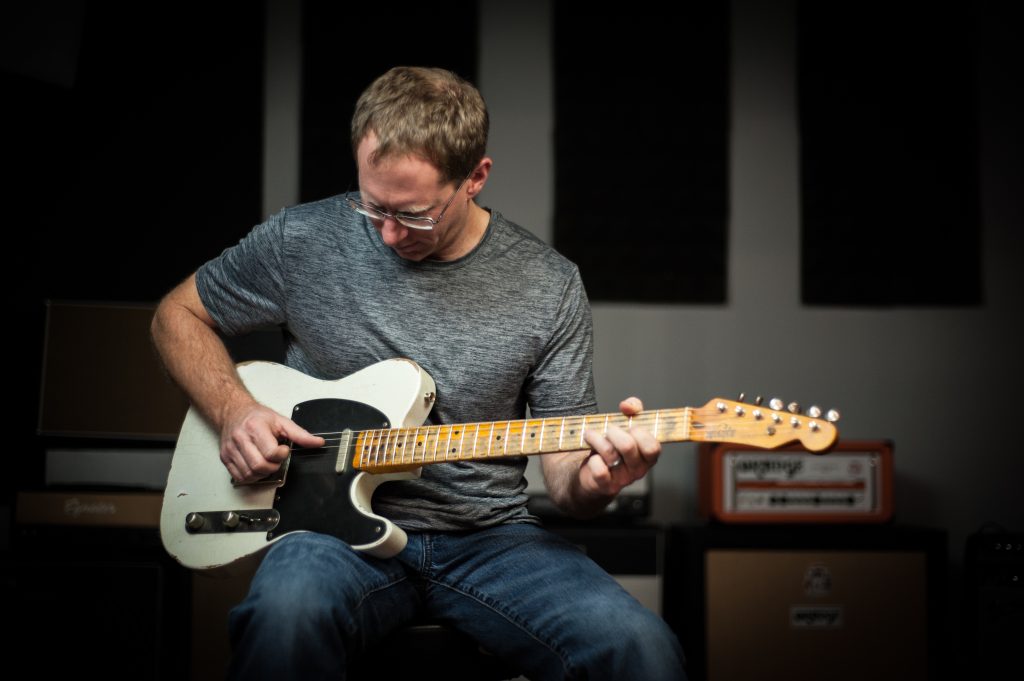
TUBES OR TRANSISTORS?
FretBuzz: You mentioned that pedals sound different depending on the gear you’re using. Do you recommend serious players use solid state amps or tube amps?
Wampler: Like so many of these questions, it depends what you’re going for. The real advantage of solid state amps is that they’re cheaper and they don’t require near the upkeep as tube amps, which run at really high voltages, so you go through valves a lot. There’s a lot more work involved. You’re going to have more problems with noise because you’re using old technology. For some of us, that’s part of the charm of tube amps. And there’s just something about a cranked, gainy tube amp that’s super hard to replicate, whether with solid state amps, digital modeling amps, or pedals. I mean, I can get a great sound with a Boss Katana, but if I can be in a room with a cranked Marshall tube amp, I’ll take that any day.
FretBuzz: What’s the real difference in sound between Tube amps and really good modelers or modeling software?
Wampler: It’s really hard to explain what that actually is, but it’s almost like this one-of-a-kind feel. There’s this give to it, and this instant response that just feels good to play. And the distortion is really pleasing. Even when I’ve played models of amps, even neural modelers [Kemper, Quad Cortex, Neural DSP, etc.], if I play for a while, at some point my ears get fatigued in a weird way that I don’t experience with a tube amp. So there’s something there — probably some weird harmonic or something — that my ears are just not in tune with, but I’ve never been able to measure it.
PUT DOWN THAT PEDAL AND PRACTICE
FretBuzz: Is it important to have just the right pedals on your pedalboard when you play a gig?
Wampler: That’s a funny one because as a gigging player, I don’t sweat that much over gear, which is odd for a guy that makes a living making pedals. I often tell people that you’ll get way more mileage out of practicing than you will out of buying a new piece of gear. I’ll buy a new piece of gear if I pick it up and it inspires me to maybe write a new part or play a really cool riff or song. That’s a keeper pedal for me, and that’s what I love about new gear. But overall, there are a lot of times when I’ll play through a Katana and it’s perfectly fine.
FretBuzz: A Katana is a great-priced multi-functional amp (see our review of the Katana-50 Gen 3). But there are now so many multi-effect units and pedals that vary greatly in price and quality. You won’t get a true Marshall Plexi sound playing through an M-Vave “Mini-EFX” pedal, but you might get close enough for a makeshift jam.
Wampler: There’s no absolute here. I’ve heard players playing through a very affordable multi-effects unit and thought they sounded fantastic. I’ve also heard people play through that and thought, “Oh my God, please turn that off.” And, again, I think a lot of that comes down to your ability on the instrument. Man, if you’re a good player, you could play through a phone book — well, that’s an old joke – but you could play through anything and make it sound good.
FretBuzz: It’s kind of like how a top pro photographer can shoot high-quality photos with a point-and-shoot camera.
Wampler: When you’ve been woodshedding for years and years and years, when to pick a little lighter or pick a little harder, you can significantly change your sound. Tone can also be affected by how you mute the strings when you’re playing and having everything intonated properly. There are all these different things that a seasoned player has done for so long that it becomes second nature. It’s the same thing with these multi-effect things. And sometimes the object is to get really unusual sounds with unconventional stuff. I know it sounds so weird coming from a pedal guy, but we get so caught up on the hardware and the software in order to make our art. But I think the most important aspect of playing is creativity, and pedals can help you get that. When you’re making your art you go, “Oh, what would be cool here. Let’s get this one particular type of sound.” And I remember this one pedal I saw on a YouTube video that makes that type of sound. So, then I’ll go chase that gear. Think about people who are great at sports. They’re great because of all that practice they put in. You could buy 200 pedals and just sit there tweaking them for days and not accomplish anything as a player.
FretBuzz: There’s a great scene in the movie This is Spinal Tap where the band is setting up to play at an air force base, and their amps keep getting interference from radio signals. But that can happen. I recently plugged in a cheap fuzz pedal and my amp received a crystal-clear broadcast from a Christian radio preacher warning listeners to avoid the wicked temptations of Satan. That was interesting, but it hardly helped me shape an ideal fuzz tone.
Wampler: Maybe that works good if you’re playing in a church band or if you want to contrast it with some really gnarly guitar noise. But pedal designers are very familiar with this thing that we call RF, which is just radio frequency. There are some things you can do to shield that out of the circuit. Basically, all the little parts in a pedal make little antennas and you can do things with the circuit to filter that stuff out and eliminate it. Fuzzes are probably the worst offenders in this area because of the way they work and the types of circuits they tend to use. And sometimes there’s nothing you can do. I’ve run across customers that live near a radio tower and, I’m sorry, but there is no way in the world you’re going to get rid of that interference other than moving. It just ain’t going to happen.
SPINNING PLATES: CHOOSING DELAYS AND REVERBS
FretBuzz: Do you recommend using reverbs and delays for ambient music or spacey modulations? And do you recommend running the two together or does that degrade the sound too much?
Wampler: That really depends on what you want to play and there are no rules. If you’re playing a U2 song, you’re obviously going to have a lot of delay and probably a lot more reverb. You’ll probably tend to use more of a hall or a plate reverb, but it’s not important not to get too caught up on what type because these are just emulations and sometimes a hall sounds more like what a plate would be. And sometimes a plate sounds more like what someone would think a hall would be. So, it’s important to try different settings and find the one you like. But delay and reverb can be used very differently in different settings. If you’re playing traditional praise and worship music in a church, you’ll probably use lots of revery and lots of delay and maybe octaves on those reverbs and delays to make the guitar sound almost like an organ. You’ll want an overall ambient guitar sound. Whereas, if you’re playing Judas Priest covers, you’re probably not going to crank up the reverb and delay that much. You probably just want a smidge – maybe 240 hertz for a slight, little echo, very little feedback (which sets how many times a signal repeats), and maybe a little bit of spring reverb so it doesn’t sound so dry and you’re playing in a little bit of space.
FretBuzz: Wampler pedals aren’t really meant for beginners. That said, do you have anything on the horizon that might be a breakthrough for a basement guitarist that won’t break the bank?
Wampler: For players that are comfortable with DAW stuff, and they’re maybe using Reaper or some other multi-tracking software, and maybe they’re recording at home or even just playing through their iPad, we have a couple of plug-ins coming out. We’ve got a modulation plug-in, the Metaverse out and a reverb plug-in coming out soon. There’s a lot of tweakability in those and they’re fun to use if you like those kinds of sounds. And, as always, if you like overdrives and distortions, that’s what we’re mostly known for. And that’s probably where my heart lies the most, I’m going to be doing more with that. I am an overdrive and distortion nut. I have more distortion overdrive pedals than I know what to do with, and it’s a sickness. Really, I need help.
